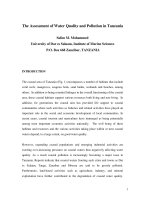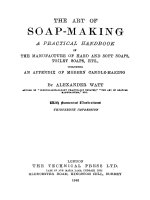The book of Soap Manufacture, by W. H. Simmons pptx
Bạn đang xem bản rút gọn của tài liệu. Xem và tải ngay bản đầy đủ của tài liệu tại đây (2.76 MB, 740 trang )
The Project Gutenberg EBook of The
Handbook of Soap Manufacture, by
W. H. Simmons and H. A. Appleton
This eBook is for the use of anyone
anywhere at no cost and with
almost no restrictions whatsoever. You may
copy it, give it away or
re-use it under the terms of the Project
Gutenberg License included
with this eBook or online at
www.gutenberg.net
Title: The Handbook of Soap Manufacture
Author: W. H. Simmons
H. A. Appleton
Release Date: June 7, 2007 [EBook #21724]
Language: English
*** START OF THIS PROJECT GUTENBERG EBOOK
THE HANDBOOK OF SOAP MANUFACTURE ***
Produced by Ben Beasley, Richard Prairie,
Josephine Paolucci
and the Online Distributed Proofreading
Team at
. (This file was
produced from images
generously made available by The Internet
Archive/Million
Book Project.)
THE HANDBOOK OF
SOAP
MANUFACTURE
BY
W. H. SIMMONS,
B.Sc. (Lond.), F.C.S.
AND
H. A. APPLETON
WITH TWENTY-SEVEN
ILLUSTRATIONS
LONDON
SCOTT, GREENWOOD & SON
"THE OIL AND COLOUR TRADES
JOURNAL" OFFICES
8 BROADWAY, LUDGATE HILL, E.C.
1908
[All rights reserved]
Transcriber's note:
Footnotes have been moved to the end of
the chapter and minor typos have been
corrected.
PREFACE
In the general advance of technical
knowledge and research during the last
decade, the Soap Industry has not
remained stationary. While there has not
perhaps been anything of a very
revolutionary character, steady progress
has still been made in practically all
branches, and the aim of the present work
is to describe the manufacture of
Household and Toilet Soaps as carried
out to-day in an up-to-date and well-
equipped factory.
In the more scientific portions of the book,
an acquaintance with the principles of
elementary chemistry is assumed, and in
this we feel justified, as in these days of
strenuous competition, no soap-maker can
hope to compete successfully with his
rivals unless he has a sound theoretical as
well as practical knowledge of the nature
of the raw materials he uses, and the
reactions taking place in the pan, or at
other stages of the manufacture. We also
venture to hope that the work may prove
useful to Works' Chemists and other
Analysts consulted in connection with this
Industry.
At the same time, in the greater part of the
book no chemical knowledge is necessary,
the subject being treated in such a way that
it is hoped those who are not directly
engaged in the manufacture of soap, but
who desire a general idea of the subject,
will find it of value.
In the sections dealing with the
composition and analysis of materials,
temperatures are expressed in degrees
Centigrade, these being now almost
invariably used in scientific work. In the
rest of the book, however, they are given
in degrees Fahrenheit (the degrees
Centigrade being also added in brackets),
as in the majority of factories these are
still used.
As regards strengths of solution, in some
factories the use of Baumé degrees is
preferred, whilst in others Twaddell
degrees are the custom, and we have
therefore given the two figures in all
cases.
In the chapter dealing with Oils and Fats,
their Saponification Equivalents are given
in preference to Saponification Values, as
it has been our practice for some years to
express our results in this way, as
suggested by Allen in Commercial
Organic Analysis, and all our records,
from which most of the figures for the
chief oils and fats are taken, are so stated.
For the illustrations, the authors are
indebted to Messrs. E. Forshaw & Son,
Ltd., H. D. Morgan, and W. J. Fraser &
Co., Ltd.
W. H. S.
H. A. A.
London, September, 1908.
CHAPTER I.
Introduction.
Definition of Soap—Properties—
Hydrolysis—Detergent Action.
CHAPTER II.
Constitution of Oils and Fats, and their
Saponification
Researches of Chevreul and Berthelot—
Mixed Glycerides—Modern Theories of
Saponification—Hydrolysis accelerated
by (1) Heat or Electricity, (2) Ferments,
Castor-seed Ferment, Steapsin, Emulsin,
and (3) Chemical Reagents, Sulphuric
Acid, Twitchell's Reagent, Hydrochloric
Acid, Lime, Magnesia, Zinc Oxide, Soda
and Potash.
CHAPTER III.
Raw Materials used in Soap-making
Fats and Oils—Waste Fats—Fatty Acids
—Less-known Oils and Fats of Limited
Use—Various New Fats and Oils
Suggested for Soap-making—Rosin—
Alkali (Caustic and Carbonated)—Water
—Salt—Soap-stock.
CHAPTER IV.
Bleaching and Treatment of Raw
Materials intended for Soap-making
Palm Oil—Cotton-seed Oil—Cotton-seed
"Foots"—Vegetable Oils—Animal Fats—
Bone Fat—Rosin.
CHAPTER V.
Soap-making
Classification of Soaps—Direct
combination of Fatty Acids with Alkali—
Cold Process Soaps—Saponification
under Increased or Diminished Pressure—
Soft Soap—Marine Soap—Hydrated
Soaps, Smooth and Marbled—Pasting or
Saponification—Graining Out—Boiling
on Strength—Fitting—Curd Soaps—Curd
Mottled—Blue and Grey Mottled Soaps—
Milling Base—Yellow Household Soaps
—Resting of Pans and Settling of Soap—
Utilisation of Nigres—Transparent soaps
—Saponifying Mineral Oil—Electrical
Production of Soap.
CHAPTER VI.
Treatment of Settled Soap
Cleansing—Crutching—Liquoring of
Soaps—Filling—Neutralising, Colouring
and Perfuming—Disinfectant Soaps—
Framing—Slabbing—Barring—Open and
Close Piling—Drying—Stamping—
Cooling.
CHAPTER VII.
Toilet, Textile and Miscellaneous Soaps
Toilet Soaps—Cold Process soaps—
Settled Boiled Soaps—Remelted Soaps—
Milled Soaps—Drying—Milling and
Incorporating Colour, Perfume, or
Medicament—Perfume—Colouring matter
—Neutralising and Superfatting Material
—Compressing—Cutting—Stamping—
Medicated Soaps—Ether Soap—Floating
Soaps—Shaving Soaps—Textile Soaps—
Soaps for Woollen, Cotton and Silk
Industries—Patent Textile Soaps—
Miscellaneous Soaps.
CHAPTER VIII.
Soap Perfumes
Essential Oils—Source and Preparation—
Properties—Artificial and Synthetic
Perfumes.
CHAPTER IX.
Glycerine Manufacture and Purification
Treatment of Lyes—Evaporation to Crude
Glycerine—Distillation—Distilled and
Dynamite Glycerine—Chemically Pure
Glycerine—Animal Charcoal for
Decolorisation—Glycerine obtained by
other methods of Saponification—Yield
of Glycerine from Fats and Oils.
CHAPTER X.
Analysis of Raw Materials, Soap, and
Glycerine
Fats and Oils—Alkalies and Alkali Salts
—Essential Oils—Soap—Lyes—Crude
Glycerine.
CHAPTER XI.
Statistics of the Soap Industry
APPENDIX A.
Comparison of Degrees, Twaddell and
Baumé, with Actual Densities
APPENDIX B.
Comparison of Different Thermometric
Scales
APPENDIX C.
Table of the Specific Gravities of
Solutions of Caustic Soda
APPENDIX D.
Table of Strength of Caustic Potash
Solutions at 60° F.
Index
CHAPTER I.
INTRODUCTION.
Definition of Soap—Properties—
Hydrolysis—Detergent Action.
It has been said that the use of soap is a
gauge of the civilisation of a nation, but
though this may perhaps be in a great
measure correct at the present day, the use
of soap has not always been co-existent
with civilisation, for according to Pliny
(Nat. Hist., xxviii., 12, 51) soap was first
introduced into Rome from Germany,
having been discovered by the Gauls, who
used the product obtained by mixing goats'
tallow and beech ash for giving a bright
hue to the hair. In West Central Africa,
moreover, the natives, especially the Fanti
race, have been accustomed to wash
themselves with soap prepared by mixing
crude palm oil and water with the ashes of
banana and plantain skins. The
manufacture of soap seems to have
flourished during the eighth century in
Italy and Spain, and was introduced into
France some five hundred years later,
when factories were established at
Marseilles for the manufacture of olive-
oil soap. Soap does not appear to have
been made in England until the fourteenth
century, and the first record of soap
manufacture in London is in 1524. From
this time till the beginning of the
nineteenth century the manufacture of soap
developed very slowly, being essentially
carried on by rule-of-thumb methods, but
the classic researches of Chevreul on the
constitution of fats at once placed the
industry upon a scientific basis, and
stimulated by Leblanc's discovery of a
process for the commercial manufacture of
caustic soda from common salt, the
production of soap has advanced by leaps
and bounds until it is now one of the most
important of British industries.
Definition of Soap.—The word soap
(Latin sapo, which is cognate with Latin
sebum, tallow) appears to have been
originally applied to the product obtained
by treating tallow with ashes. In its strictly
chemical sense it refers to combinations
of fatty acids with metallic bases, a
definition which includes not only sodium
stearate, oleate and palmitate, which form
the bulk of the soaps of commerce, but
also the linoleates of lead, manganese,
etc., used as driers, and various
pharmaceutical preparations, e.g.,
mercury oleate (Hydrargyri oleatum),
zinc oleate and lead plaster, together with
a number of other metallic salts of fatty
acids. Technically speaking, however, the
meaning of the term soap is considerably
restricted, being generally limited to the
combinations of fatty acids and alkalies,
obtained by treating various animal or
vegetable fatty matters, or the fatty acids
derived therefrom, with soda or potash,
the former giving hard soaps, the latter
soft soaps.









